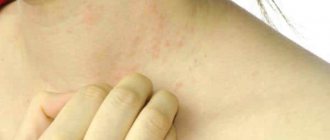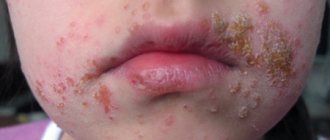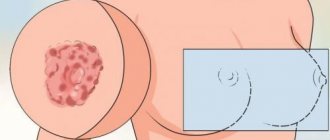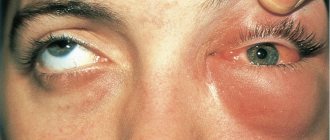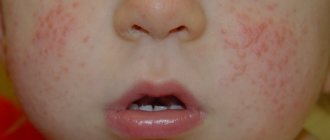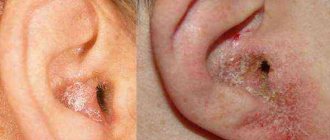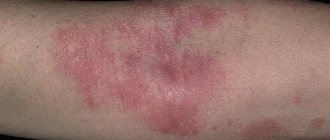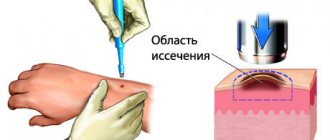Causes
The cause of infectious dermatitis is the destruction of the skin by pathogens. All layers of the skin from the epidermis to the deep layers of the dermis and even fatty tissue can be affected.
The destruction of the skin leads to the fact that it ceases to perform a protective function, due to which pathogens of new infections can penetrate through it.
Prerequisites for the occurrence of infectious dermatitis may include : mechanical damage to the skin, allergic reactions, stress, radiation exposure or poisoning with certain poisons, invasions and genetic predisposition.
How to cure viral dermatitis
First of all, if you have any irritation on the skin, the way of which you have no idea how it appeared, you should consult a dermatologist. He will already examine you and create a suitable treatment system. You must also adhere to the following recommendations:
- Carry out treatment for dermatitis based on the doctor’s recommendations and a comprehensive
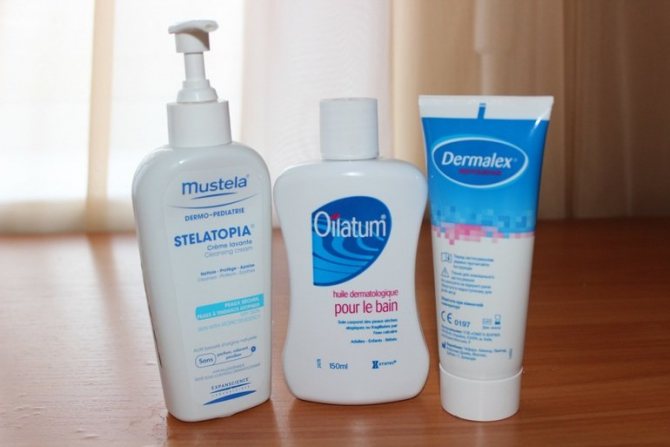
approach; - Determine the nature of the primary disease and eliminate repeated contact;
- Use antiseptics that will disinfect the surface of the skin and prevent the disease from spreading further;
- Remedies that eliminate itching and can relieve inflammation;
- And of course, the most important means of treatment are antibacterial drugs, which must destroy pathogenic and harmful microorganisms during the course of treatment, or stop their reproduction.
Treatment at home, or as it is also called - local treatment - will not guarantee the final disappearance of all pathogens of dermatitis, so you should consult doctors and not treat with what “relatives advised”. This is especially true for the treatment of viral dermatitis in infants, children and adolescents, since it is their body that requires strong immunity during this period.
Main symptoms of infectious dermatitis
The infected person may experience a variety of symptoms:
- With measles , a rash appears on the face, and the next day it spreads throughout the body;
- With scarlet fever, small blisters form, which disappear, followed by the appearance of dry scales and peeling within 2-5 days (Dermatitis, in which the rash looks like pimples, is called papular);
- Typhus is interesting because it causes infectious dermatitis mainly in the flexure areas of the joints, as well as around the mammary glands and on the abdomen. Dermatitis appears on the 3rd day after infection;
- With chickenpox, pink bubbles cover almost the entire human body, after which they burst to form a crust;
- Fungal dermatitis is characterized by the appearance of redness, peeling, pain and burning;
Appearance - photo gallery
After infectious dermatitis, pigmentation occurs, which can remain for life.
The most common types of dermatitis in dogs
Since there are many causes of dermatitis and their combinations, the disease can be of different types. Each of them is characterized by its own distinctive symptoms and treatment approaches. The most common types of dermatitis in dogs are briefly described below.
With pyotraumatic dermatitis in dogs, the infection penetrates from the surface into the deeper layers of the skin, leaving behind plaques and a thickened stratum corneum. The deeper it penetrates, the more papules (pimples) and pustules (pustules) will appear on your pet’s skin.
Treatment consists of using antibacterial drugs.
Allergic dermatitis is considered the most common in dogs, since any object can be an allergen. Experts note that in most cases, skin allergies are provoked by external parasites, food and cosmetic care products. Symptoms include: severe itching, redness of the skin, scratching, rashes, swelling.
The basis of treatment is elimination of the allergen and symptomatic therapy.
Treatment consists of identifying and eliminating the allergen, carrying out symptomatic therapy, and preventive measures to prevent otitis media.
The salivary secretion of fleas contains more than a dozen allergenic components that lead to flea dermatitis in dogs. The severity of symptoms depends on the individual susceptibility of the animal. Signs of pathology can be: alternating wet areas and areas covered with crusts. In the chronic course of the disease, the pet exhibits excessive skin pigmentation on the abdomen and hair loss. It is characteristic that the dog’s ears, muzzle and paws are almost not affected.
Treatment consists of getting rid of fleas and symptomatic therapy. Prevention is of great importance for recovery - the use of a parasite collar, disinsection of the environment in which the dog lives.
Interdigital dermatitis in dogs, or pododermatitis, develops between the animal's toes, mainly on the front legs. If the lesions are single, it can be assumed that the disease is provoked by injury. With extensive damage to the limbs, the cause may be insects, allergies, or infections. Symptoms: bleeding nodules, boils, pain leading to lameness.
Seborrheic dermatitis is caused by genetics. With this disease, the process of keratinization of the skin accelerates, which is visually manifested in numerous scales, oily epidermis, but dry hair. Your pet may have brittle nails; The inflammatory process on the skin is clearly visible, accompanied by severe itching. In the future, the disease is complicated by secondary infection with all the ensuing consequences.
Treatment is carried out in two directions: local therapy and a systemic approach.
Symptoms of acral dermatitis include thick, ulcerated patches of skin caused by your dog licking the area excessively. Pathological behavior of an animal can be caused by allergies, parasites, infection and other factors that must be detected and eliminated before treating the skin.
Treatment consists of the initial elimination of the provoking factor and a therapeutic effect on the damaged epidermis. Limiting your pet's access to the itchy area is of great importance. In addition, antidepressant and psychotropic drugs are used in therapy.
Danger to life and health
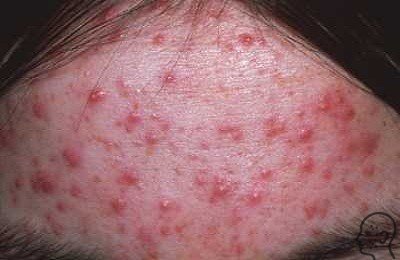
A number of infectious diseases that cause dermatitis are accompanied by high fever, pain, dizziness, and the like.
Related article:
What to do with atopic dermatitis on the hands of adults and children?
for children . It causes large layers of skin to peel off, similar to a sunburn. The temperature rises above 38 degrees, lethargy and apathy are observed, the child loses appetite.

Staphylococcus is difficult to treat at any age; in addition to the skin, the mucous membranes and lymph nodes can become inflamed. In especially severe cases, the bacterium can also affect internal organs: intestines, kidneys, etc. In adults, staphylococcal infection is milder than in children.
You also need to remember that staphylococcus is very contagious, every fifth person in the world is infected with it, and about 60% of people are periodically infected, but then completely cured.
Dermatitis from parasites
Helminths in the body cause many unpleasant and dangerous conditions for human health.
Parasitic dermatitis is one such manifestation. This disease is more common in children. Treatment of allergic manifestations is labor-intensive and lengthy due to the specific nature of the parasites.
If atopic dermatitis manifests itself, you should seek help from a qualified specialist to conduct a thorough examination and prescribe effective therapy.
The mechanism of dermatitis from parasites
Allergic reactions are an immune response to foreign molecules entering the human body. The main causes of allergens include parasites (giardia, roundworms and others) and single-celled organisms. Highlighting various factors for the manifestation of allergies:
- dead worms and their decomposition;
- secretion of helminths’ own metabolites;
- mechanical damage in tissues.
Helminthic infestations reduce human immune defenses.
The larvae of worms (giardia, roundworms, pinworms and others) provoke initial allergic reactions, releasing proteases and the enzyme hyaluronidase. These substances can cause inflammation, which helps parasites enter certain organs (usually the intestines) and create a special environment for their development.
After the development of worms into adults, the main causes of dermatitis include the waste products that they secrete.
In addition to allergy manifestations caused by metabolites of parasites, certain types of worms can make people sensitive to other allergens (pollen, dust, animal dander, etc.).
What parasites are causing the problem?
Powerful intoxication processes occur during the treatment of roundworms. This is explained by the total weight of parasites of this group, which can reach 500 grams or more. To the greatest extent, allergies are caused by the influence of parasite larvae on human tissue.
Roundworms (in most cases larvae) after penetrating the intestines enter the circulatory system, and then into the liver, heart organ and respiratory system.
If they enter the respiratory tract, it causes a cough, the function of which is to throw the larvae into the mouth, from where they are swallowed again.
Severe itching of the skin can be caused by schistosomes.
The penetration of different types of worms into the skin or other organs is called larva migrans syndrome. Those capable of causing cutaneous forms of the syndrome include larvae of schistosome, hookworm, acne and other parasites. You can become infected with such worms while walking barefoot or while swimming in infected water (ponds, lakes).
A more dangerous condition is the visceral (visceral) form of the syndrome, which is caused by the larvae of Toxocara, Toxascar and other parasites that attack internal organs.
Such infections are accompanied by severe manifestations of allergic reactions, the symptoms of which include: dry cough, fever and allergic exanthema. Giardia in the human body mainly causes atopic dermatitis, neurodermatitis and eczema.
A patient infected with Giardia suffers from nervous disorders, insomnia and disturbances in the gastrointestinal tract against the background of severe itching.
Atopic dermatitis in children
Atopic dermatitis occurs in many children of different ages. This may be due to helminths (roundworms, trichinella, lamblia and others) living in the child’s body.
A sign indicating that a child is infected with parasites includes elevated levels of eosinophils in a blood test. In such a situation, the doctor prescribes additional tests to identify parasites in the child’s body.
With parasitic infection, symptoms in children appear immediately; along with the manifestations of atopic dermatitis, the following is observed:
- a decrease in weight indicators or, conversely, a sharp increase in them;
- signs of strangulation;
- headaches;
- pain in the abdominal area;
- unpleasant odor from the mouth;
- manifestations of anemia;
- joint discomfort.
Other symptoms
Very often, with neurodermatitis against the background of allergic reactions, problems with the gastrointestinal tract arise.
The most common symptoms of an allergic reaction to worms include rashes, severe skin burning and bronchodilator spasms.
During numerous examinations of patients diagnosed with atopic dermatitis (neurodermatitis) in combination with parasitic diseases, the following characteristic abnormalities were discovered:
- disturbances in nutrition and blood supply to the mucous membrane in the gastrointestinal tract;
- changes in the levels of digestive enzymes, resulting in a failure in the absorption of foods;
- failure in the secretion and movement of bile;
- changes in immune system parameters;
- the accumulation of active biological elements in the body, due to which autoallergy (allergic reactions to one’s own organs and tissues) and internal intoxication are formed.
How to get rid of dermatitis?
Getting rid of dermatitis due to parasite infection is a labor-intensive and lengthy process. Treatment for allergic manifestations will bring results only in combination with therapy aimed at eliminating worms. For accurate diagnosis, clinical studies are prescribed.
If the presence of parasites in the human body is confirmed, then the attending doctor selects drugs to destroy the parasites, assessing the condition of the individual patient. You should not self-medicate; all antiparasitic drugs are very toxic and can harm the body.
In cases where studies do not reveal the presence of parasites, but allergic symptoms do not go away, you can resort to a course of deworming using traditional recipes.
You can prepare folk methods for fighting parasites yourself or buy them at the pharmacy.
If treatment with the above methods is ineffective, you should undergo a thorough examination to identify the root cause of atopic dermatitis.
Source: https://InfoParazit.ru/u-cheloveka/vidy-i-simptomy/dermatit-pri-parazitah.html
Treatment
Infectious dermatitis is treated with external and internal means.
The following drugs are used externally :
- Antiseptics (hydrogen peroxide, brilliant green, various products based on ethyl or formic alcohol);
- Anti-inflammatory drugs (Betadine, Advagantan);
- Antibiotics for external use (Bactroban, Gentamicin, Syntomycin and others).
They also use methods of physical influence: UHF, laser cauterization, etc.
It should be taken into account that antibiotics are used only against bacterial infections; they do not help at all . Infectious-allergic dermatitis requires the use of antihistamines. Fungal disease is treated with such drugs as Atifin, Batrafen, Ifenek, Candibene, Lamisil and other ointments.
For internal use, antipyretics (for fever), antibiotics (for bacterial dermatitis), and antiviral drugs (for viral dermatitis) are used.
Purulent microbial dermatitis requires the use of powerful antiseptics (potassium permanganate, hydrogen peroxide), emollients and kerolitic ointments.
Why does the disease develop?
Many factors lead to the development of dermatitis in dogs. Among the main reasons are:
- damage to the skin of varying degrees (insect bite, scratching, wound);
- medicines (most often, these are external preparations used for a long time, for other purposes or in high concentrations);
- thermal effects;
- infection of various origins;
- parasites (fleas, lice and others);
- internal disorders (often endocrine in nature);
- allergies to internal and external influences (food, medications, hair care products, etc.).
Traditional methods of treatment
Infectious dermatoses and dermatitis can also be treated with folk remedies.
- For most types of skin lesions honey helps a lot. Lubricate the affected area regularly so that a thin layer of honey is constantly present on the skin, and the redness and itching will go away in a few days;

- In some cases you can use juice of flowering celandine, but since it is quite caustic, it can only be used after consulting a doctor, otherwise it can only make things worse;
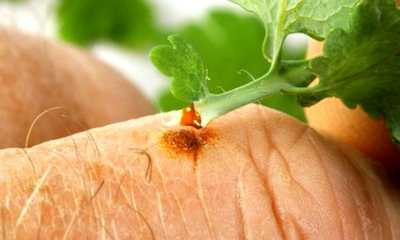
- Tar or soap based on it helps a lot. As in the previous case, a preliminary consultation with a dermatologist is needed to determine whether this remedy can be used or not. It is recommended to do a test by applying tar to a healthy area of skin;
- absolutely harmless and safe remedy is potatoes , which are applied to the affected area for an hour or two. The potato must be raw, clean, without peel (a slice of pulp is attached);
- Various oils, such as tea tree or geranium, can help.
Related article:
Atopic dermatitis - symptoms and treatment in adults
Diagnostics
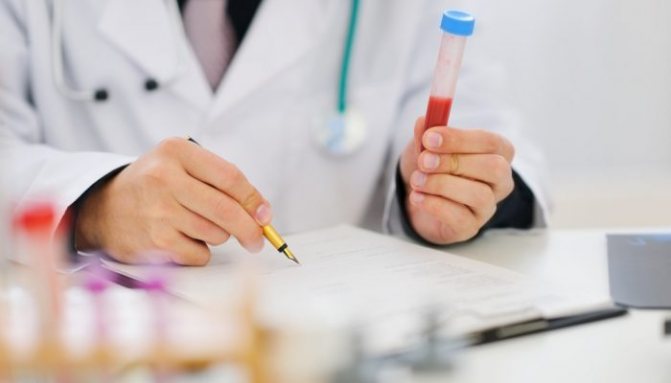
Infectious dermatitis can also be identified by clinical signs. But the cause of skin changes is reliably determined based on the results of additional methods:
- General blood tests (leukocyte count, ESR).
- Serological tests (antibodies to microbial agents).
- Studies of discharge from skin elements (microscopy, culture, PCR).
To clarify the diagnosis, consultation with an infectious disease specialist is indicated. In case of systemic disorders and damage to internal organs, there is a need for a corresponding expansion of the range of diagnostic measures.
Prevention
The fungus usually “sticks” to already affected skin, so the best prevention of fungal dermatitis is to keep the skin in order: if it is too wet or oily, wash with laundry soap, use creams for oily skin.
For dry, cracking skin, softening ointments are suitable. If cracks appear, they need to be treated with antiseptics. Banal cleanliness of the skin is of great importance.
Infectious inflammation of the skin caused by bacteria or viruses can only be prevented by isolating yourself from the source of infection - an animal or a sick person.
If a disease is transmitted from person to person, the behavior of already sick people will play an important role in preventing the epidemic. Having received a diagnosis and learned that it is contagious, large bacterial or viral dermatitis should isolate itself as much as possible from loved ones, especially children.
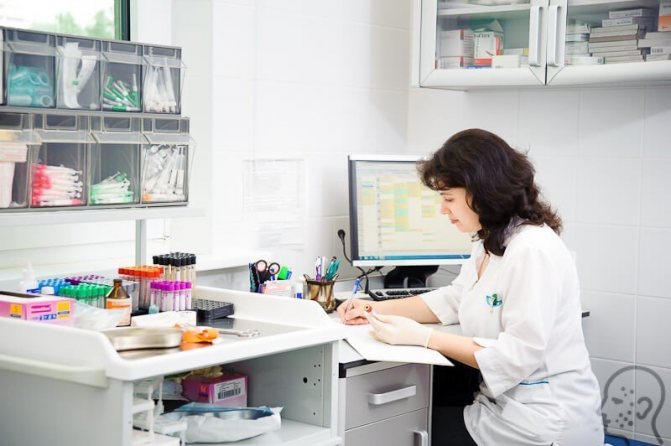
Vaccines have been developed against some diseases.
To prevent epidemics, it is necessary to explain to the population what infectious dermatitis is, what are the causes of these diseases, the main routes of transmission, and the importance of vaccinations. In the event of an epidemic, it is important to isolate the epidemic outbreak as soon as possible. During outbreaks of disease in animals (vesicular dermatitis), farm animals are usually destroyed, and domestic animals may be isolated for a time.
Pathogens
The main cause of the disease is infection in the body. Dermatitis affects the skin of children and adults due to the penetration of certain types of viruses, which occur most often in children. It appears when infected:
- measles,
- rubella,
- chickenpox (in adults - herpes zoster),
- enterovirus infection.
The causes of skin damage should be sought in concomitant diseases in which the virus attacks the body. Sometimes the problem can be caused by parasites (scabies, typhus).
Infectious dermatitis as an independent disease is provoked by the following microorganisms:
- streptococci (scarlet fever),
- staphylococci,
- bacterium Treponema pallidum (syphilis),
- fungus (most often Candida).
In these cases, changes in the skin are not a symptom, but a specific disease.
Viral dermatitis, as an independent phenomenon, is not contagious: the skin lesion itself is not transmitted . You can only become infected with infections that contributed to the occurrence of dermatitis. Depending on the type of pathogen, it can be transmitted by contact, airborne droplets, sexual contact, household contact, or through abrasions or scratches on the body.

